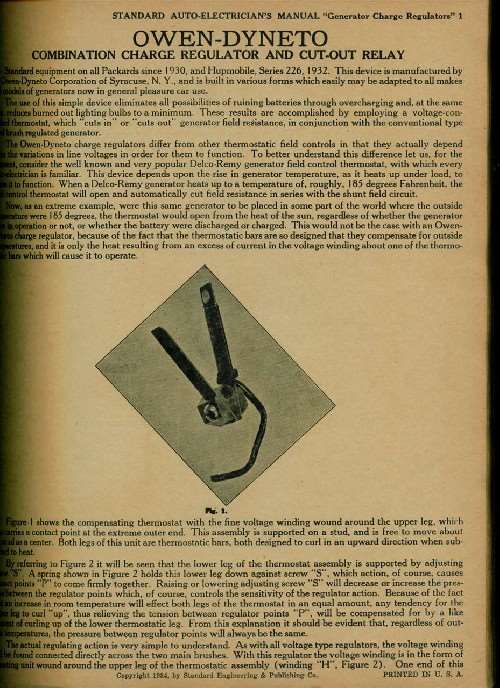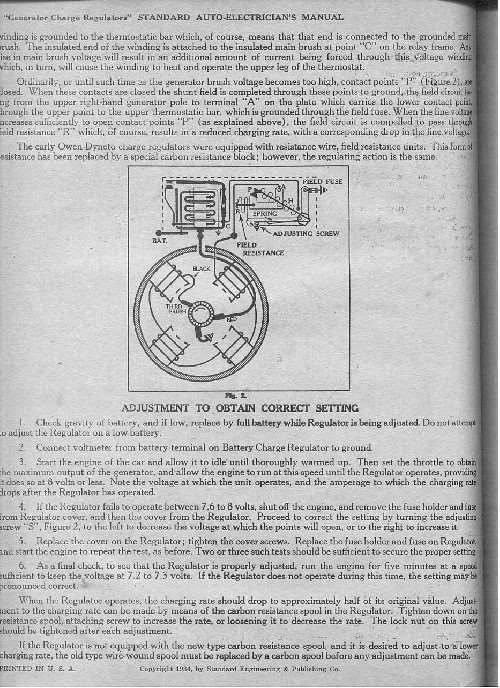|
Re: 1934 1103 generator
|
||||
|---|---|---|---|---|
|
Forum Ambassador

|
Hi Terry:
First of all, removing the generator does not require any diassembly of the front engine cover and timing chain drive. You simply remove the 3 nuts holding the generator in place, and then separate the generator from the bronze sleeve or "snout" that separates the generator from the engine block casting, and just slide the generator rearwards, making sure the bronze sleeve stays in place - it holds the gear drive and timing chain in place within the timing chain housing. As to brushes, I've never been able to get my hands on any - but you can adapt something, no doubt. I'm sure our friend Jason from AER will have information about that, and also about the so-called "regulator" - that's a bit of a misnoner since it doesn't regulate current - you have a third brush generator so the positioning of the 3rd brush controls the amperage. The "regulator" is a voltage control and cutout. NORS regulators (O-D 21262 I believe) have just recently been discontinued by NAPA and I'm not aware of any source for them, but apparently there are some alternatives. Again, Jason Smith is probably the best source of information on this as he makes his living doing this, and in the past I've found him very helpful. Jason visits this site occasionally, here's his info: Jason Smith Advanced Electrical Rebuilders 16574 S. Bauer Rd Grand Ledge, MI 48837 www.aerrebuild.com toll-free: 1-866-228-0218
Posted on: 2012/5/21 7:57
|
|||
|
||||
|
Re: 1934 1103 generator
|
||||
|---|---|---|---|---|
|
Home away from home
|
Cheers Dave, Very helpful info. Have you any idea why the sudden loss of charge and how do I check tings with a meter or is this a question for Jason.
Posted on: 2012/5/21 10:08
|
|||
|
||||
|
Re: 1934 1103 generator
|
||||
|---|---|---|---|---|
|
Forum Ambassador

|
There's a fuse and a set of contact points within the Dyneto regulator. The fuse may be insulated by a paper sleeve that might have deteriorated so check that. Also there is a set of points within the unit - you might want to clean and dress the points lightly. There are special abrasive tools made exclusively for cleaning such points; if you don't have one, don't use an abrasive paper, but rather an ignition point file. Look for a break in the very fine thermal wire on the voltage control, and if intact (hopefully) be VERY CAREFUL not to break it.
A description of the unit and instructions for adjusting are attached from the A.E.A., Edition T, 1934.
Posted on: 2012/5/21 10:21
|
|||
|
||||
|
Re: 1934 1103 generator
|
||||
|---|---|---|---|---|
|
Home away from home
|
Dave,
I have just checked the fuse and points and everything looks like new with the little thermal wire still intact. I could only just read the aea chart but it is still difficult to read. is it on the packard site?
Posted on: 2012/5/21 11:32
|
|||
|
||||
|
Re: 1934 1103 generator
|
||||
|---|---|---|---|---|
|
Forum Ambassador

|
Terry, it's probably on the PAC site, I don't recall. But I'll just email it to you and you can manipulate the image as needed. In my views it's all legible, though pg1 is easier on the eyes.
Posted on: 2012/5/21 13:38
|
|||
|
||||
|
Re: 1934 1103 generator
|
||||
|---|---|---|---|---|
|
Home away from home
|
Dave,
Do I read it correctly that the timing chain/generator drive will not dissolve into the timing case? Will the bronze sleeve try to come out and is it part of the gear drive or a support for the genny drive? What disaster could take place if it does come it?
Posted on: 2012/5/22 4:37
|
|||
|
||||
|
Re: 1934 1103 generator
|
||||
|---|---|---|---|---|
|
Forum Ambassador

|
Terry, never had a problem removing a generator with this type of installation, the fit between the bronze sleeve and the generator is not a snug, precision fit and besides, it is oonstantly bathed in oil so they should separate easily. After you remove the 3 retaining nuts, just use a screwdriver or similar to get a little separation between the generator front flange and bronze part, then hold the bronze in place and slide the generator rearwards. Otherwise you'll be removing the radiator, front timing chain cover, and probably the oil pan. You may want a second pair of hands, the generator is no lightweight.
Posted on: 2012/5/22 8:00
|
|||
|
||||
|
Re: 1934 1103 generator
|
||||
|---|---|---|---|---|
|
Home away from home
|
There will be two of us working on it and hopefully with your info no problems will be encountered but its best to prepare. One final question Dave what's the purpose of the slotted flange on the generator, some kind of adjustment?
Thanks again Terry
Posted on: 2012/5/22 13:35
|
|||
|
||||
|
Re: 1934 1103 generator
|
||||
|---|---|---|---|---|
|
Forum Ambassador

|
The generator rotates a bit so you can adjust as slack develops in the timing chain. There is a plug on the horizontal surface of the timing chain cover, just below the ventilation scupper IIRC - the plug looks just like the oil pan and transmission drain plugs. You remove it and adjust the tension by feeling the slack with your finger. You are feeling the chain on a very long span, so you want it to NOT be taut, but with about 1/2 of deflection.
Posted on: 2012/5/22 14:03
|
|||
|
||||

 (173.68 KB)
(173.68 KB)







